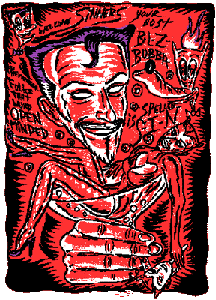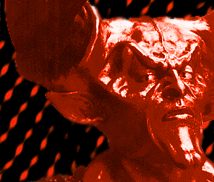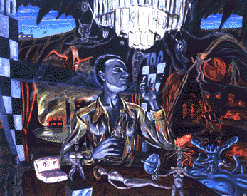

[ Features Index | Metro | Metroactive Central ]
 Satan Doll
Satan Doll
The devil is making
a comeback on screen
and stage--but,
really, he never left
By Richard von Busack
Art by David Sandlin
Satan is having an unusually busy time lately, turning up in one of the year's best movies, The Usual Suspects, in addition to cameos in Tales From the Hood and The Prophecy--and possibly Seven, depending on your theological bent. The devil has also satanically inspired one of the year's best records, Randy Newman's Faust, and religious historian Elaine Pagels has written a new scholarly biography of Old Scratch (The Origin of Satan; Random House).
If Satan didn't have so much good taste, he'd be on the chat shows, demurely turning aside both the backhanded praise of Letterman and the fury of Oprah's choir. In the meantime, the devil is up to his usual tasks: haunting preschools, luring teenagers to sex and suicide, influencing the mass media, supporting abortion clinics, and involving himself in any number of churches that you, the reader, may not like.Pop culture, as always, delves into what people think as opposed to what they're supposed to think. Or, as Kierkegaard wrote, "An unconscious relationship is more powerful than a conscious one." The presence of the devil in the popular art of skeptics shows his power to evoke fright, or at least interest, even among the sophisticated.

Even more from Metro about the Prince of Darkness!
Satan is everywhere! Even on the web!

As an engaging figure in art, Satan is always a pleasure to watch and hear and laugh about--so thrilling, so dashing, so unfailing in his ability to scare away bores. In movies, he's such a sardonic wit that many of the screen's great villains have either played him or longed to do so. In operas or musical comedies, he dominates the action, like the peerless symbol of rebellion he is.
The Intimate Enemy
But there's another devil besides the great Satan of literature, stage, screen and hot-sauce bottle label: a mysterious spirit whose opposition begins in the service of the Lord, and who, even after rebellion, does God's bidding thoroughly. Whatever shudders Satan wrings out of the studio audience, he serves his master by punishing the evil and ushering the ungodly to the just desserts they somehow missed on earth.

Bloody Hell: British character actor
Tim Curry as
Lucifer in Legend.
Satan, as Pagels (who also wrote Adam, Eve, and the Serpent) notes, began as "the intimate enemy," the devil you know. At the end of her The Origin of Satan, it's clear that Satan, who started as the embodiment of turncoats, was transformed into an exterior, foreign force who lures people to their doom. Pagels outlines how this spirit began as God's agent provocateur trying to persuade Job to give up his faith. But even in hazing Job, Satan is following God's directions explicitly. As Neil Forsyth put it in his 1987 study, The Old Enemy, the early Satan was "a shady and necessary member of the Politburo."
While earlier accounts of Jehovah (such as the book of Isaiah) have God stating that he created both good and evil, the problem of God's responsibility for evil creates a need for a God of Evil, a need that Satan fulfills. Throughout the Old Testament, Satan takes the names of various gods to whom the Israelites were held in thrall at one time or another: Astaroth, or Astarte, is also known as Ishtar; Baal's name is the source for Beelzebub.
The land of the Jews was invaded again and again, which is the reason for the lamentations and prayers for revenge in the Old Testament. Judea was part of the Roman Empire by the time of the birth of Jesus, and there were some among the hereditary Jewish rulers who had been lured by the cultural and political treasures Greco-Roman civilization offered. The Empire brought an armed peace in a part of the world where fighting has never been rare, and even some self-rule for the Jewish leaders.
The elusive good side of the Roman reign was ending by the time Jesus reached adulthood. The Roman governor Pontius Pilate was notorious as what you could call a crucifying-judge. Meanwhile, in Rome, the maniac emperors Caligula and later Nero had decreed themselves gods, and intended to be worshipped in all parts of the Empire, including Judea, much to the horror of the Jews.
Jesus was influenced enough by the revolutionary Essenes to be baptized by John, an Essene. The Essenes were monks who avoided contact with the Romans and other foreigners, held their goods in common and practiced celibacy. Much history of Satan, or the Prince of Darkness, was found in the Dead Sea Scrolls, unearthed in the ruins of the Essene community of Qumran, Israel, in 1947.

Art by David
Sandlin
Even if there hadn't been a sketchy tradition of Satan and his angels in the Old Testament and other Jewish writings, Pagels says, the Essenes would have invented one. In asking how God's servant becomes his adversary, she writes, the Essenes were really asking about those who wanted to cooperate with the occupying Gentiles: "How could one of us become one of them?"Since the early Christians essentially developed in an era of increasing persecutions by the Roman Empire, all of the New Testament has combat as its background. The references in the final chapter of the New Testament, the book of Revelations, to the Whore of Babylon and the Antichrist, all reflect the troubles of the occupied Jews, and of the Christians who came, at first, from their ranks.
"Christianity would have had a much easier time without the book of Revelations, though it would be a much less colorful religion," writes Susan Turner in The History of Hell. Revelations, the source for much lore about the imminent end of the world, has long been either the most frightening or the most ludicrous part of the Bible, depending on the perspective of the reader.
The tradition of a vengeful Satan dates from the persecutions of Christians by various Roman emperors, even by the enlightened Marcus Aurelius. These persecutions are one aspect of Christian lore that is not exaggerated, and the longing for vengeance is all over church lore like a coat of red paint.
The early Christian theologian Tertullian (c. 160-230) is certain that the faithful will someday watch their tormentors burning in Hell. It will be as pretty a picture as fish jumping in a reservoir, he says. The fear of heresy also originates from these three centuries before the Emperor Constantine converted to Christianity on Oct. 27, 312. A guerrilla church scattered in communities throughout the Roman Empire was basically creating its own systems of belief. It is for this reason that St. Paul's various epistles (some written by him, others forged in his name) counsel so frequently against false prophets and doctrines inspired by Satan.
The possible directions that the Church might have taken if certain choices had been made in the 1st and 2nd century are worthwhile topics for discussion. The Egyptian theologian Origen has been excommunicated four times, thrice after his death, for his "apocastasis," the belief that after a time eventually Satan apologizes, and is forgiven, Hell is closed, and everyone concerned gets to go home. (It's such a seductive idea that Pope Leo XIII had to proclaim the eternity of Hell as recently as 1879.)
And the Gnostic gospels, such as the Gospel of Philip, suggests that a person reborn in Christ becomes "holy, down to the very body," "no longer a Christian, but a Christ." In the Gospel of Philip, the seeker must learn his capacity for evil by looking inward and searching his own heart, an essential step toward purification.
This knowledge, "gnosis" in Greek, is the key to the Gnostic heresy, a popular opponent to the early organized Christian church. Imagine, for a moment, Western civilization having these traditions to lead it--of eventual reconciliation, and of the inner light--instead of the traditions that prevailed: the double coronation of an authoritarian church and Satan as the Prince of Darkness.
Ever since the era that produced the heated imagery of the book of Revelations, Satan has been an inspiration to folk art, giving us the scariness of the treble six (picked up straight from Jewish secret teachings of numerology, the kaballa), Bible comics, televangelism and movies such as The Omen series. Revelations also contains the only biblical reference to Satan being the serpent in the Garden of Eden, thus closing the circle by identifying Satan as "that old serpent," man's enemy from the beginning of time.
Fearful Disclosures
Panic is a word that describes the terror of seeing the Greek god Pan, the horned, goat-shanked god of fertility who is a forebear of the devil. The panic waxes and wanes depending on electronic broadcasting--Geraldo Rivera is the Cotton Mather of the cathode ray, giving his imprimatur to self-proclaimed experts on Satanism. While the movies delight in seductive charmers, the tabloids go for the jugular.
Al Carlisle, of the Utah State Prison System (quoted in Jack Chick's comics and in the Rev. Jerry Johnston Edge of Evil: The Rose of Satanism in North America) claims that between 40,000 and 60,000 unfortunates are victims of ritual Satanic murderer each year. Now, that is a lot of dead bodies.
Popular eschatology (or literature of the last days) provides some of the devil's most entertaining adventures. Stories of Satanic abductions still terrify Americans despite the suspicious lack of evidence.
No one's turned up any more convincing signs of the devil's handiwork than spray-painted pentagrams, empty beer bottles and the graffitied names of Satanic heavy-metal bands that, in rock critic Nick Tosches' phrase, "wouldn't scare their beautician's poodle."
(Even the rumors of knackered pets may be more prevalent than the real thing. A few years back, Anton LaVay, head of the Church of Satan in San Francisco, was giving a tour of his temple to a reporter; a cat ran out, and the reporter commented on the notion that Satan likes dead cats. An unamused LaVay picked up his kitty protectively and threatened the wrath of Satan on anyone who mistreats animals. If you really tremble before the awesome majesty of Satan, leave my cat alone!)
Historic conspiracies all have one thing in common--inevitably, somebody has to blow it, as Jeffery S. Victor writes in his Satanic Panic: The Creation of a Contemporary Legend (Open Court Books, 1993). The Thuggee and the Mafia, cults in which it was worth your life to squeal, did, in the fullness of time, produce squealers. Where's the Carmen Valachi or the Jimmy "The Weasel" Fratiano of Satanism?
Personal testimony from children and abductees is the only evidence, and the former is often coaxed from children by investigators. See the book Remembering Satan about a recent tragic witch hunt in Olympia, Wash., where police detectives bullyragged children into confessions of flying through the air and being forced to eat filth and molest dogs.
Satan isn't remembered for the thrill of it; real-life traumas may produce fantastic visions, just as mental debilitation will, and there are always real-life copycat killers. As in voodoo, all you need is people convinced of the power for the power to work. The overbooked Satan of the 1990s is a symptom of economic hardship, of inequality and deprivation. If you believe his unholy hand turns the handle on the abortion mills, it's not an enormous logical step to imagine sacrifices of babies to him.
In the pre-Civil War period, another time of upheaval and agitation, Satanic metaphors proved convenient slings to use against slavers and Catholics alike. The arrival of Irish and Italian Catholics in the 1840s, fleeing poverty in Europe, fueled the fury of those nativists who thought the devil had traveled with these immigrants.
Victor points out that the classic of regressed-memory lore, Michelle Remembers, bears amazing parallels to 1836's The Awful Disclosures of Maria Monk, the bestselling secular book in American history until Uncle Tom's Cabin. The baby murderers, rapists and torturers in Maria's disclosures weren't a coven. They were priests and nuns in the Montreal convent where she had been a novice.
The risen Satan is responsible, in some minds, for the effort to unite all nations and to condone birth control and sterilization, which brings down the native birthrate. A nativist politician talking about the American way under siege, the cultural war on, may not find the word "Christian" equivalent to "American," but he does know what the Essenes knew, in using combat metaphors that go back to Ezekiel: foreigners are the devil.
Pagels cites anthropologist Robert Redfield that early human consciousness throughout the world frequently involves a pair of divisions: between man and animals, and between the tribe and outsiders. Satan, both beast and foreigner, is the symbol of the nether half of the two divisions. "The struggle within the Christian tradition," Pagels writes, "is between the profoundly human view that 'otherness' is evil and the words of Jesus that reconciliation is divine."
True, Satan hasn't prevailed everywhere. In Europe and in the more prosperous parts of America, "Hell has become something of an embarrassment, and a bishop who resorts to threats of damnation is quickly roasted by the popular press," writes Turner. The Unitarian/Universalist doctrine calls Hell "the foulest imputation on the character of God that can be imagined," and this 100-year-old doctrine has had an influence on organized religion.
The human love of God can be proved to have made the world, on the whole, richer, but fear of Satan can't be proved to have done any good. To paraphrase Proudhon's famous comment about the law, fear of Satan is a chain to the meek and a cobweb to the powerful. George Bernard Shaw described Satan fear as "a pathological symptom of that particular sort of conscience and nervous constitution which brings its victims under the tyranny of two delirious terrors, the terror of sin and the terror of death, which may be called also, the terror of sex and the terror of life."
Add to that the terror of outsiders, whose relationship with God is not as sacred as our own. Still, Satan can be laid down by studying him in the light of day. Such study is our only slight hope of sharing the planet or saving it: of course, the two ideas are one and the same.
[ Features Index | Metro | Metroactive Central ]
This page was designed and created by the Boulevards team.
Copyright
© 1995 Metro Publishing and Virtual Valley, Inc.